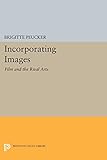Incorporating Images : Film and the Rival Arts / Brigitte Peucker.
Material type: TextSeries: Princeton Legacy Library ; 300Publisher: Princeton, NJ : Princeton University Press, [2014]Copyright date: ©1995Edition: Course BookDescription: 1 online resource (240 p.) : 2 halftones on 12 pagesContent type:
TextSeries: Princeton Legacy Library ; 300Publisher: Princeton, NJ : Princeton University Press, [2014]Copyright date: ©1995Edition: Course BookDescription: 1 online resource (240 p.) : 2 halftones on 12 pagesContent type: - 9780691600673
- 9781400864027
- 791.43/01 20
- PN1995.25
- online - DeGruyter
- Issued also in print.
| Item type | Current library | Call number | URL | Status | Notes | Barcode | |
|---|---|---|---|---|---|---|---|
 eBook
eBook
|
Biblioteca "Angelicum" Pont. Univ. S.Tommaso d'Aquino Nuvola online | online - DeGruyter (Browse shelf(Opens below)) | Online access | Not for loan (Accesso limitato) | Accesso per gli utenti autorizzati / Access for authorized users | (dgr)9781400864027 |
Browsing Biblioteca "Angelicum" Pont. Univ. S.Tommaso d'Aquino shelves, Shelving location: Nuvola online Close shelf browser (Hides shelf browser)

|

|

|

|

|

|

|
||
| online - DeGruyter Paths of Emancipation : Jews, States, and Citizenship / | online - DeGruyter Antonio Candido : On Literature and Society / | online - DeGruyter Timely Meditations : Martin Heidegger and Postmodern Politics / | online - DeGruyter Incorporating Images : Film and the Rival Arts / | online - DeGruyter Mousterian Lithic Technology : An Ecological Perspective / | online - DeGruyter The Experiences of Tiresias : The Feminine and the Greek Man / | online - DeGruyter Right Thinking and Sacred Oratory in Counter-Reformation Rome / |
Frontmatter -- Contents -- Illustrations -- Acknowledgments -- Introduction -- CHAPTER 1. Movement, Fragmentation, and the Uncanny -- CHAPTER 2. Monstrous Births: The Hybrid Text -- CHAPTER 3. Incorporation: Images and the Real -- Afterword -- Notes -- Index
restricted access online access with authorization star
http://purl.org/coar/access_right/c_16ec
Film, a latecomer to the realm of artistic media, alludes to, absorbs, and undermines the discourses of the other arts--literature and painting especially--in order to carve out a position for itself among them. Exposing the anxiety in film's relation to its rival arts, Brigitte Peucker analyzes central issues involved in generic boundary crossing as they pertain to film and situates them in a theoretical framework. The figure of the human body takes center stage in Peucker's innovative study, for it is through this figure that the conjunction of literary and painterly discourses persistently articulates itself. It is through the human body, too, that film's consciousness of itself as a hybrid text and as a "machine for simulation" makes itself deeply felt.In films ranging from Weimar cinema through Griffith, Hitchcock, and Greenaway, Peucker probes issues in aesthetics problematized by Diderot and Kleist, among others. She argues that the introduction of movement into visual representation occasioned by film brings with it an underlying tension suggestive of castration and death. Peucker goes on to demonstrate how the encounter between narrative and image is both gendered and sexualized, rendering film a "monstrous" hybrid. In a final section, she explores in specific cinematic texts the permeable boundary between the real and representation, suggesting how effects such as tableau vivant and trompe l'oeil figure sexuality and death.Originally published in 1995.The Princeton Legacy Library uses the latest print-on-demand technology to again make available previously out-of-print books from the distinguished backlist of Princeton University Press. These editions preserve the original texts of these important books while presenting them in durable paperback and hardcover editions. The goal of the Princeton Legacy Library is to vastly increase access to the rich scholarly heritage found in the thousands of books published by Princeton University Press since its founding in 1905.
Issued also in print.
Mode of access: Internet via World Wide Web.
In English.
Description based on online resource; title from PDF title page (publisher's Web site, viewed 30. Aug 2021)


